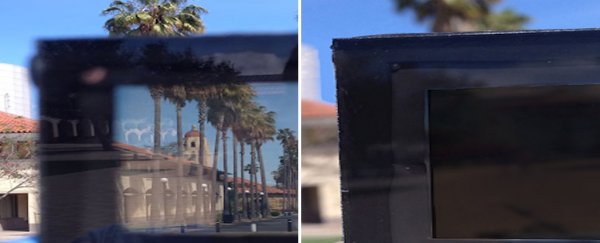Scientists have developed a brand-new type of electronic window that can switch from transparent to opaque, and back again, in under one minute.
Even though similar 'dimmable glass' already exists, this invention relies on completely new technology, and if it's successfully scaled up, we could soon kiss goodbye to ugly window shades.
"We did not tweak what was out there, we came up with a completely different solution," says researcher Michael McGehee, from Stanford University.
"We've had a lot of moments where we've thought, 'how is it even possible that we've made something that works so well, so quickly,' and we're now running the technology by glass and other kinds of companies."
You may have been lucky enough to get a seat next to a smart window on your last holiday or business trip. The Boeing 787 Dreamliner was the first plane to replace cumbersome window shades with a button that could change the window from transparent to a very dark blue colour.
The current smart windows place a thin layer of a gel between two glass plates and applying an electrical current causes a chemical reaction that changes the opacity.
But that type of smart window has some serious drawbacks.
That technology tends to use expensive materials such as tungsten oxide and can take up to 20 minutes to change colour. The chemical nature of the gel also means that it will degrade over time making the window less and less opaque – something that hasn't gone unnoticed by travellers.
What did this study do differently?
McGehee and his group's prototype blocks light by flooding the window with copper and another metal in response to an applied current. The window needs to be conductive too, and is made from transparent indium tin oxide modified by platinum nanoparticles.
When the current is switched on, the metal ions saturate the conductive glass plates physically blocking out the light. In transparent mode, the window lets through about 80 percent of the light and in opaque mode it only lets in about five percent.
The window has been cycled between on and off a total of 5,500 times without degradation in the opacity levels – a sign of its stability and future potential.
As for the speed of transition, the window is able to be switched between the two states very quickly and here is a video of the window in action:

Credit: Mark Shwartz / YouTube
The clip also holds clues to what needs to happen before we'll see these in our everyday lives – the design needs to be scaled up.
The prototype covers an area just 5cm x 5cm, not yet useful for most private or commercial applications.
Scaling up comes with its own challenges, however. To make sure that the technology is commercially viable, they must be less expensive than windows already on the market. The team is targeting a cost around 50 percent of what the alternative gel windows cost.
Should they reach their target, the new technology has far-reaching implications.
"We're excited because dynamic window technology has the potential to optimise the lighting in rooms or vehicles, save about 20 percent in heating and cooling costs, and even change the way people wear sunglasses" says McGehee.
"This is an important area that is barely being investigated at universities, and there's a lot of opportunity to keep us motivated".
The study has been reported in Joule.
